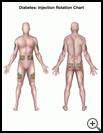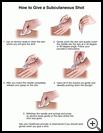
Diabetes: Types and Activity of Insulin
________________________________________________________________________
KEY POINTS
- Insulin may be used to control blood glucose (sugar) if your child has diabetes.
- The main types of insulin are rapid-acting, short-acting, intermediate-acting, long-acting, ultra-long-acting, and pre-mixed. Your child’s healthcare provider may prescribe one or a combination of different types of insulin to treat your child’s diabetes and to match your child’s needs, eating schedule, and lifestyle.
- Make sure you know how and when your child needs to take the medicine. Your child should not take more or less than your child is supposed to take.
- Ask the healthcare provider, certified diabetes educator, or pharmacist what side effects the medicine may cause, and what you should do if your child has side effects.
________________________________________________________________________
What is insulin used for?
Insulin may be used to treat diabetes by controlling blood glucose (sugar) levels. It is a hormone normally made by the pancreas, which is an organ in your upper belly behind your stomach. Your body uses insulin to help move glucose from the blood into the cells.
Children with diabetes have problems with the way insulin is used in their bodies. When your child’s body does not make enough insulin or has trouble using the insulin the body makes, glucose cannot get into the cells and builds up in your child’s blood. Too much glucose in the blood can damage the blood vessels and organs.
- With type 1 diabetes, your child does not make insulin and needs to take insulin shots.
- With type 2 diabetes, your child’s body may make insulin, but not enough, or your child’s body may not be able to use insulin well. Your child may be able to control blood glucose levels through a mix of healthy food choices, physical activity, and weight loss if needed. And your child may take medicines by mouth to help the body make more insulin or to use the insulin the body does make. In some cases, your child may need to take insulin. Sometimes, your child will need insulin only during times of illness or other stress.
Your child needs the right kind of insulin at the right times during the day. The amount and kind of insulin is very important. If your child takes too much insulin, takes the wrong type, or takes it at the wrong time, your child could have a serious or life-threatening low blood glucose reaction. If your child doesn't take enough insulin or forgets a dose, your child’s body will not be able to use food for energy, glucose from digested food will stay in the blood, and the blood glucose will be too high.
How does it work?
Your child’s body needs insulin to move glucose from the blood into the cells, where it is used for energy. The body cannot turn glucose into energy without insulin. If insulin is not available, glucose from digested food builds up in the blood. Insulin controls blood glucose levels but does not cure diabetes.
Types of insulin include:
- Rapid-acting insulin, which may be injected or inhaled
- Regular or short-acting insulin
- Intermediate-acting insulin
- Long-acting insulin
- Ultra-long-acting insulin
- Pre-mixed insulin
Concentrations of insulins include:
- U-100 insulin, which is the type most people use
- U-200, U-300, and U-500, which are other concentrations given with an insulin pen
Your child's healthcare provider may prescribe one or a combination of different types of insulin to treat your child’s diabetes. You and your child’s provider, certified diabetes educator, or pharmacist will work on an injection (shot) schedule that fits your child’s needs, eating schedule, and lifestyle.
Your child should not stop using insulin without talking to your child’s healthcare provider. Your child should not switch to another brand or type of insulin or change the dose of any type of insulin your child uses without talking to your child’s healthcare provider.
Insulin comes in small bottles, prefilled disposable dosing devices, and cartridges. The cartridges are usually used in dosing pens.
Many people find insulin pens simple and easy to use. A pen includes both the vial and the syringe. Insulin is given by pushing a button on the pen. Certain pens can be used more than one time and have a memory function to recall the last insulin dose and time it was given. Connected insulin pens (CIPs) record and send this data electronically. Healthcare providers may use this information to change your treatment.
Insulin types and concentrations vary on how fast they start to work, when they peak, and how long they last. Make sure you are aware of the type and concentration of insulin that your child’s healthcare provider has prescribed for your child. Be sure you know what type of container your child’s insulin comes in and what other supplies, such as needles, syringes, or pens, your child will need to take the medication. Use only the device prescribed by your child’s provider to give insulin. Do not share your child’s devices with anyone else. Make sure that the name and letter on your child’s insulin are exactly what your child’s healthcare provider prescribed.
What else do I need to know about this medicine?
- Follow the directions that come with your child’s medicine, including information about food and alcohol for an older child. Make sure you know how to store the insulin and other medicines. Make sure you know how and when your child needs to take the medicine. Your child should not take more or less than he or she is supposed to take.
- Make sure your child carries glucose to take if blood glucose levels get too low. Glucose tablets or gel are good for emergencies.
- Have your child carry a medical ID such as a card or bracelet that says your child has diabetes.
- Try to get all of your child’s prescriptions filled at the same place. Your pharmacist can help make sure that all of your child’s medicines are safe to take together.
- Keep a list of all the medicines your child takes, including the type and dose of insulin your child uses. Tell your child's healthcare provider and pharmacist about all the prescription and nonprescription medicines, natural remedies, vitamins, and supplements your child takes.
- Many medicines have side effects. A side effect is a symptom or problem that is caused by the medicine. Ask your healthcare provider what side effects the medicine may cause and what you should do if your child has side effects. This medication causes changes in your child’s blood glucose level. You and your child should know the symptoms of low and high blood glucose and what to do if your child has these symptoms.
- Talk to your child’s healthcare provider about where on the body to inject insulin. The best places to give insulin are the belly, upper arms, thighs, and buttocks. Rotate the injection sites and use a chart to keep track of the sites used.
- If you have any questions, ask your child’s healthcare provider, certified diabetes educator, or pharmacist for more information.
Last modified: 2022-03-15
Last reviewed: 2022-02-05


